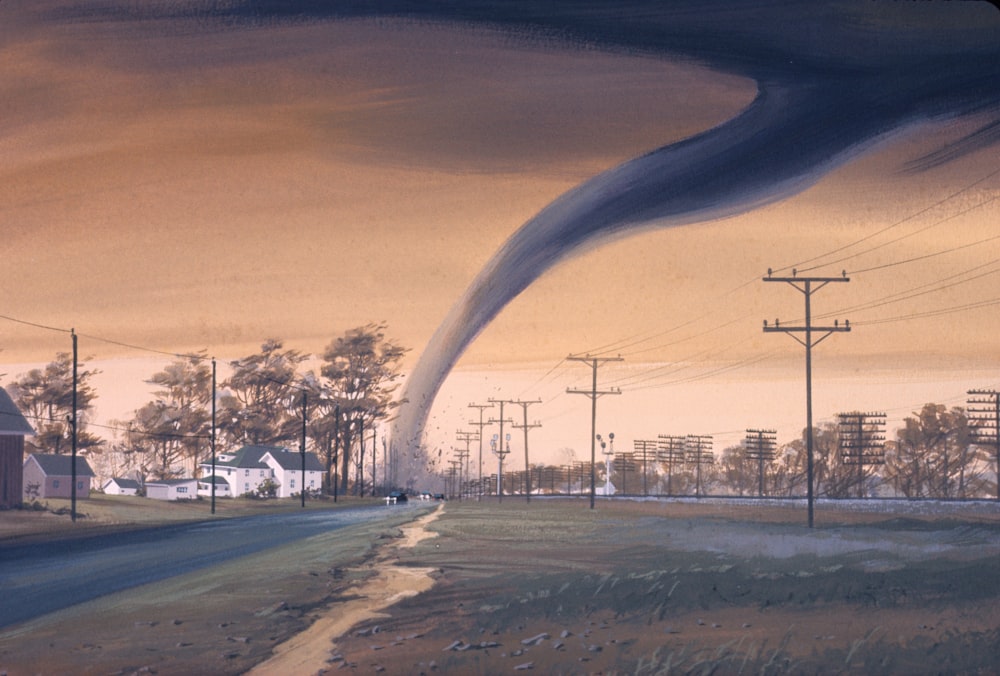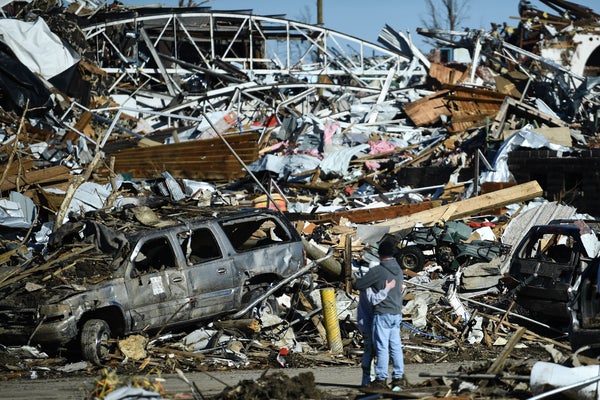(866)223-5699
(866)223-5699


A tornado is a violently rotating column of air that extends from the base of a thunderstorm to the ground. They can be up to 1 mile wide, and travel for dozens of miles at speeds over 300 mph. Tornadoes are often accompanied by severe thunderstorms and large hail, and cause significant destruction in their path. The most destructive tornadoes have wind speeds of 250+ mph and can leave entire towns flattened. Some tornadoes may also spawn waterspouts or land spouts if they move over bodies of water or open fields. Those types of tornadoes usually do not cause as much damage as larger ones on land, but still must be taken seriously due to their unpredictable nature. It is important to know what safety precautions should be taken before, during, and after a tornado. Taking cover in the lowest level of your home, staying away from windows and covering yourself with blankets or mattresses can help protect you if a tornado is approaching. Knowing what to do in advance can potentially save lives during a storm.
Tornadoes can be very dangerous, depending on their size and strength. According to the National Severe Storms Laboratory (NSSL), an average of 80 deaths occurred each year from 1980–90 due to tornadoes in the US. The strongest tornado on record was the El Reno Tornado that touched down in Oklahoma in 2013 with wind speeds approaching 300 mph. This tornado was 1.6 miles wide at its peak and left a path of destruction over 17 miles long. It is important to take every tornado seriously, no matter how small or weak it may appear, as they can all cause serious damage and loss of life if not taken seriously.
There are several signs that a tornado may be coming, including large hail, strong winds, dark skies, and loud roaring noises. If you notice any of these signs before or during a storm, it is important to take cover in the lowest level of your home and wait for the storm to pass. Other signs of an impending tornado include an approaching cloud of debris from the ground up into the sky, and persistent rotation in low level clouds. It is also wise to stay tuned to local news sources for warnings about tornadoes so you can be prepared ahead of time if one is expected in your area.
Unfortunately there are no ways to completely prevent tornadoes from occurring since they are often caused by severe weather patterns. However, it is possible to reduce the risk of death and damage from a tornado by taking certain safety precautions. Knowing what to do before a tornado warning, during, and after a tornado can help people stay safe if one should occur in their area. Taking cover in the lowest level of your home, staying away from windows, and covering yourself with blankets or mattresses can help protect you if a tornado is approaching. It is also important to stay informed about severe weather forecasts so you can be prepared ahead of time for any potential tornadoes. Additionally, building codes and regulations can play an important role in reducing the destruction caused by a tornado. Adhering to strict building standards and making sure homes are up to code can help ensure they will be able to withstand strong winds associated with a tornado. Taking these measures can help reduce the risk of death and serious damage from tornadoes.
Tornadoes can form over bodies of water, but they are usually weaker than those that occur on land. These types of tornadoes, known as waterspouts or land spouts if they move over open fields, typically have weaker wind speeds and do not cause as much damage as their counterparts on land. However, it is still important to take them seriously due to their unpredictable nature. Even weak tornadoes can cause serious damage if they hit populated areas or boats at sea, so it is important to be aware of potential storms in the area and take safety precautions wherever possible.
Waterspouts are more common over large bodies of water, such as oceans and lakes, but they can also occur over smaller bodies like rivers and streams. So it is important to be aware of potential storms in the area and take safety precautions wherever possible.
Tornadoes can be very dangerous and cause severe damage and loss of life if not taken seriously. Knowing what to do before, during, and after a tornado can help people stay safe if one should occur in their area. Taking cover in the lowest level of your home, staying away from windows, and covering yourself with blankets or mattresses can help protect you if a tornado is approaching. Additionally, adhering to strict building codes and regulations can play an important role in reducing the destruction caused by a tornado. By taking these safety precautions and staying informed, people can help reduce the risk of death and serious damage from tornadoes.

The majority of tornadoes in the US occur in a region known as Tornado Alley, which includes parts of Texas, Oklahoma, Kansas, Nebraska, South Dakota, and Iowa. Other states that experience frequent tornadoes include Alabama, Mississippi, Georgia, Louisiana, Arkansas, and Florida. Tornadoes can occur anywhere in the United States during any season; however, the highest frequency tends to be from April through June when warm air meets cold air over areas such as Tornado Alley. It is important to stay alert and informed about severe weather forecasts regardless of where you live so you can be prepared ahead of time for any potential tornadoes. Stay safe!

Buildings made from weaker materials, such as wood frame homes or mobile homes, are most vulnerable to being damaged by a tornado. Older buildings that may not have been built to adhere to strict building codes can also be more prone to damage. High-rise buildings, however, are generally better equipped to withstand the strong winds associated with a tornado due to their design and construction features. Additionally, structures that have been retrofitted with storm window shutters, anchoring systems, and other protective measures can help reduce the amount of damage caused by a tornado. Taking these measures can help safeguard your property and help reduce the risk of serious destruction in case of an approaching tornado. Stay safe!

The best way for people living in Tornado Alley to prepare for a tornado is to stay informed of severe weather forecasts, create an emergency plan and have supplies ready. It is important to be aware of signs that may indicate a tornado is approaching, such as dark clouds, hail and rotating cloud patterns. Additionally, it can be beneficial to have a portable radio on hand so you can keep up with the latest forecast and warnings. Having an emergency kit stocked with essential items like food, water, blankets and first aid supplies can also help ensure you are prepared if a tornado strikes. Taking these measures and following recommended safety procedures can help keep you safe during a tornado. Stay safe!

It is believed that some animals, such as birds, cats and dogs, have the ability to detect a tornado before it occurs. It is thought that these animals can sense changes in barometric pressure or changes in air flow that occur prior to a tornado. Additionally, cats may be able to see low-level clouds associated with some tornadoes through their ultraviolet vision. While there is no definitive way to know when a tornado is coming ahead of time, being aware of potential signs from your pet may help give you more notice so you can get to safety if one should occur. Stay safe!'

Every resident who lived in tornado areas understands how uncertain it is to face an imminent storm. Take care of your family and your property by following this checklist of storm safety strategies. In general, US tornadoes are about 1200 per day. Notoriously impossible to forecast tornadoes leave the trail of destruction. Although tornadoes generally have occurred over the South and the Midwest, tornadoes are possible at any location depending upon weather. A tornado not only has high winds but also has dangerous flying debris.
Tornadoes can cause serious damage and injury, so it is important to be prepared. Here are some tips to help you prepare for a tornado:
1. Know the signs of an impending storm. Watch for dark, greenish skies; large hail; and a loud roar similar to a freight train. If you notice any of these signs, seek shelter immediately.
2. Decide on a safe location in your home or workplace where family members or coworkers can go if necessary—such as a basement or interior room without windows on the lowest level of the building.
3. Make sure that everyone knows how to respond quickly and calmly in the event of an emergency, including information about what to do
if you are separated from one another during the storm.
4. Keep emergency supplies on hand, such as flashlights and fresh batteries, a first aid kit, blankets or sleeping bags, canned food and plenty of bottled water.
5. Have a home evacuation plan in place should it become necessary to leave your residence due to severe weather conditions. Make sure everyone knows where they should go and how they will get there.
6. Stay informed by listening to local news reports for updates on tornado warnings and other severe weather advisories in your area. Be prepared to take action if you hear a warning issued for your location.
7. Check your insurance coverage regularly to make sure it is up-to-date and adequate to cover any possible tornado-related damage.
By taking these simple steps and staying informed, you can help ensure the safety of your family and property in the event of a tornado. With proper preparation, you can be ready for whatever Mother Nature throws your way.
To learn more about tornado preparedness and safety, visit the National Weather Service website at www.weather.gov/tornado. Here you will find valuable information and resources on how to stay safe during severe weather events. You can also learn how to prepare a tornado emergency kit and plan ahead for storms. Be sure to check out the NWS’s interactive storm tracker map that allows you to monitor current conditions in your area so that you always know what is coming your way! Again, thank you for reading and stay safe!
Leave a comment